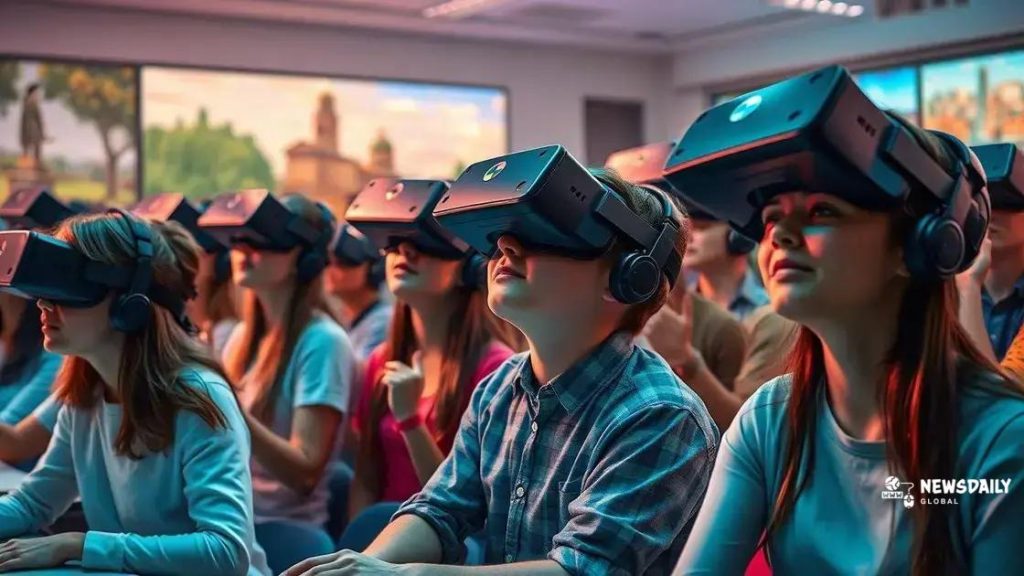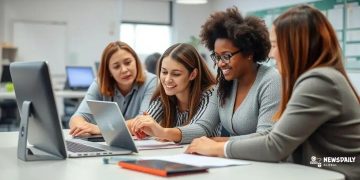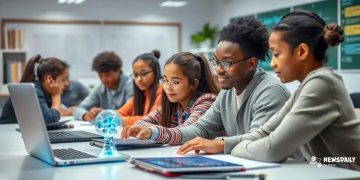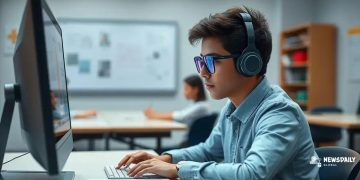Virtual reality in classrooms: engage students effectively

Virtual reality in classrooms enhances education by providing immersive, engaging learning experiences, making lessons more interactive and accessible for students, while fostering collaboration and personalized learning opportunities.
Virtual reality in classrooms is changing how we engage students today. Imagine stepping into a historical event or exploring the solar system without leaving your seat. Curious about how this technology can reshape learning? Let’s dive in!
Understanding virtual reality technology
Understanding virtual reality technology is essential for incorporating it into classrooms. This technology creates immersive experiences that can engage students in ways traditional teaching methods cannot. In essence, virtual reality (VR) allows users to enter a digital environment, feeling as if they are part of the experience.
What is Virtual Reality?
Virtual reality uses computers to create realistic simulations. These simulations can involve images, sounds, and even tactile sensations. Users typically wear headsets that display 3D environments, giving them a sense of presence within that space. Because of this, learners can explore concepts first-hand, making the educational experience much more engaging.
Key Features of VR
- Immersion: Users feel fully present in their virtual environment.
- Interactivity: Learners can manipulate and interact with objects and scenarios.
- Simulation: Allows for realistic practice in a safe environment.
- Accessibility: Students can visit places or situations they may never experience in real life.
These features make virtual reality technology uniquely suited for educational purposes. Imagine students walking through ancient cities or performing surgery in a controlled setting. This form of learning can drastically improve retention and understanding of complex subjects. Moreover, VR can adapt to various learning styles, offering personalized educational experiences for every student.
Furthermore, the advancement in technology has made VR more accessible to schools. Lightweight headsets and user-friendly software mean that teachers can easily integrate VR into their lesson plans. Classrooms equipped with VR can offer students a fresh perspective, making learning less about memorizing facts and more about engaging with the material dynamically.
As educational systems evolve, understanding virtual reality technology will play a significant role. Embracing this technology may open doors to innovative teaching methods, enhancing the learning environment for both educators and students.
Benefits of virtual reality in education
The benefits of virtual reality in education are impressive. This innovative technology transforms how students learn by fully engaging them in the content they are studying. With VR, learning becomes an interactive journey, making lessons more memorable.
Enhanced Engagement
One of the main advantages of VR is the level of engagement it offers. Students are more likely to pay attention and be involved in their lessons when they are exploring a virtual environment. This hands-on experience can motivate learners who might struggle with traditional teaching methods.
Improved Retention
- Experiential learning: Students remember information better when they experience it directly.
- Emotional connection: VR can create emotional responses, helping students connect with the material.
- Active participation: Engaging actively with content leads to deeper understanding.
Additionally, VR allows students to practice skills in a safe setting. For example, medical students can perform virtual surgeries without any of the risks associated with real procedures. This practice helps build confidence and competence.
Collaboration is another significant benefit. Students can work together in virtual spaces, whether they are in the same room or across the globe. This collaboration fosters teamwork and communication skills, which are crucial in today’s world. As they navigate virtual environments, learners share ideas and solve problems together.
Furthermore, virtual reality can cater to different learning styles. Students who learn best through visual or kinesthetic experiences can thrive in VR settings, as they can explore and interact with the lessons in immersive ways. By accommodating various preferences, VR helps ensure that all students have the opportunity to succeed.
In summary, the benefits of virtual reality in education are vast and can lead to more effective learning. As schools begin to adopt this technology, they can pave the way for a more engaging and inclusive educational landscape.
Best practices for implementing VR in classrooms

Implementing virtual reality in classrooms can have a transformative effect on teaching and learning. To make the most of this exciting technology, it’s important to follow best practices that ensure both teachers and students benefit from the experience.
Planning and Preparation
The first step is thorough planning. Educators should identify learning objectives and determine how VR can help achieve them. It’s crucial to choose the right VR tools and software that align with these objectives. Involving students in the planning process can also help gauge interest and tailor the experience to their needs.
Training for Educators
- Hands-on training: Teachers should try VR equipment themselves to understand its capabilities.
- Workshops: Regular training sessions can help educators stay updated on the latest VR trends and applications.
- Peer support: Establish a support network where teachers can share experiences and techniques.
Once the educators are well-prepared, it’s essential to engage students. Before starting a VR session, provide an introduction that explains what to expect. This can help reduce any anxiety and increase excitement among students.
In the classroom, make sure to manage the time effectively. VR lessons should be integrated into the curriculum without overwhelming students. Allow enough time for exploration and discussion after the VR experience. This ensures students can reflect on what they learned and how it relates to their studies.
Assessing the impact of VR on learning is also vital. Teachers should gather feedback from students about their experiences. This could include surveys or discussions about what they enjoyed and found beneficial. Monitoring performance can help evaluate whether VR has met the learning objectives set at the beginning.
Cultivating a positive classroom environment can further enhance the VR experience. Encourage collaboration among students as they explore new environments together. This interaction not only builds teamwork skills but also allows for shared learning experiences.
In conclusion, by following these best practices for implementing VR in classrooms, educators can ensure that technology enhances the learning process. When used effectively, VR can create an engaging and enriching educational experience that resonates with students.
Examples of successful VR projects in schools
Examples of successful VR projects in schools demonstrate how this technology can enhance the educational experience. When implemented effectively, VR can lead to engaging and impactful learning opportunities for students.
Virtual Field Trips
Many schools have begun using VR for virtual field trips. For instance, students can visit historical landmarks or explore natural wonders without leaving their classrooms. This immersive experience allows students to learn about different cultures or ecosystems in exciting ways.
- National Geographic: Offers VR experiences that take students to locations like the Grand Canyon or the Amazon rainforest.
- Google Expeditions: Provides interactive VR tours of famous landmarks and museums around the world.
- Google Arts & Culture: Allows students to virtually explore art museums and exhibitions.
This type of learning caters to visual and experiential learners, making lessons more memorable.
STEM Education Initiatives
Some schools have embraced VR in their STEM (science, technology, engineering, and mathematics) programs. Virtual reality simulations allow students to conduct experiments in a safe environment. For example, students can manipulate molecules in a chemistry lab simulation or learn physics concepts by designing virtual roller coasters.
These projects not only deepen understanding but also spark interest in STEM careers. By using engaging tools, teachers can inspire the next generation of scientists and engineers.
Language Learning Programs
VR has also made a significant impact on language learning. Schools report that using VR environments can help students practice their language skills in realistic settings. They might shop in a virtual market or navigate a city while practicing conversation skills.
- Immersive language programs: Enable students to role-play real-life scenarios that enhance learning.
- Cultural immersion: Provides exposure to cultural contexts that enrich language learning.
These immersive experiences can increase student confidence and fluency, making language learning more engaging.
From virtual field trips to innovative STEM projects, schools leveraging VR technology demonstrate clear benefits for students. As more educators explore these examples, the potential for enhancing education continues to grow.
Future trends in virtual reality for education
The future trends in virtual reality for education are exciting and full of potential. As technology continues to evolve, VR is expected to play an even greater role in classrooms around the world. This evolution promises to enhance learning experiences significantly.
Increased Accessibility
One trend is the increased accessibility of VR technology. As prices drop and devices become more user-friendly, more schools will be able to afford VR tools. This means that students from diverse backgrounds can benefit from immersive learning experiences.
Adaptive Learning Environments
Another trend is the development of adaptive learning environments within VR. These environments will use artificial intelligence to customize lessons for each student. By tailoring experiences to individual needs, learning can become more effective. This personalization can help students grasp complex topics at their own pace.
Growth of Remote Learning
The expansion of remote learning is also influencing the future of VR in education. Students who are unable to attend classes physically can participate in virtual classrooms. VR will enable them to interact with teachers and peers in real-time, enriching their learning experience.
- Live streaming events: Students can attend lectures and participate in discussions from anywhere.
- Collaborative projects: Students can work together in virtual spaces, even if they’re miles apart.
- Access to global resources: Learners can explore different cultures and environments, broadening their understanding of the world.
This ability to connect across distances encourages collaboration and cultural exchange, which are important in today’s global society.
Additionally, VR content creation is on the rise. More educators are being trained to design their own VR lessons. This means that learning materials will be more relevant and engaging to students. The involvement of teachers in content creation can lead to innovative approaches to traditional subjects.
With these trends, the future of virtual reality in education looks promising. As this technology develops, it will not only enhance learning but also prepare students for a world that increasingly relies on advanced technologies.
FAQ – Questions about Virtual Reality in Education
How does virtual reality enhance student learning?
Virtual reality provides immersive experiences that engage students, making lessons more interactive and memorable.
What are the future trends for VR in classrooms?
Future trends include increased accessibility, personalized learning environments, and enhanced remote collaboration for students.
What are some successful examples of VR projects in schools?
Successful projects include virtual field trips, STEM simulations, and immersive language learning programs.
How can teachers implement VR effectively?
Teachers should plan lessons carefully, provide proper training, and encourage collaboration among students during VR activities.






